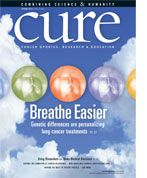Publication
Article
CURE
Biomarkers Help Patients Make Better Medical Decisions
Author(s):
The information gleaned from cancer biomarkers can be both a treasure chest and a Pandora’s box.
"How is this even possible?” she recalls asking. As a project coordinator at the American Cancer Society’s headquarters in Atlanta, she quickly devoured every bit of information at her fingertips. “When your doctor says, ‘You have breast cancer,’ your world stops,” she says. She was relieved to know that her cancer was highly treatable. But the presence of the BRCA mutation meant that her cancer was not an unlucky fluke, but a threat programmed into her cells.
Tricia Jeffers wasn't as worried about the cancer she had as she was about the one she didn't have. During her annual checkup last year, her doctor found two lumps in her right breast. He was confident that one was a cyst. The other gave him pause, however, and a biopsy soon confirmed his suspicions. Jeffers, 41, and the mother of an 11-year-old son, had an early-stage malignancy. As part of the diagnosis and because of her young age, her doctor ordered a laundry list of genetic tests on her tumor and blood. None of her relatives had ever had breast cancer, so Jeffers was shocked when results confirmed she had inherited a genetic mutation of the BRCA2 gene that increased her risk of developing breast, ovarian and other types of cancer.
This kind of harbinger was unknown a generation ago. Yet, cancer care is heading in a new direction, as patients and their doctors are increasingly able to make treatment decisions based in large part on a cancer’s invisible biochemical clues. These bits of information, called biomarkers, only a few of which are inherited, are helping patients better understand the highly individualized risks and benefits of certain treatments.
For Jeffers, harboring an inherited BRCA2 mutation led her to decide to undergo a double mastectomy. “I didn’t want to have to go through cancer twice,” she says. “I wanted it over and done with.” Other difficult choices await: She knows she has a high risk of developing ovarian cancer, too, but is not yet ready to part with her ovaries.
This complexity is one reason the discovery of cancer biomarkers can be both a treasure chest and a Pandora’s box. There was a time when a cancer’s molecular secrets were largely a mystery, so doctors relied on the information they had in front of them to recommend treatment: How advanced was the cancer? What did it look like under a microscope? What type of tissue did it come from? But with the revolution in gene-hunting technology—enabling doctors to find genetic changes at astonishing speed—patients can make medical decisions based on the biochemical changes no one can see.
A cell’s genes contain the instructions for making all the molecules that keep life going. Cancer occurs when these instructions go haywire, allowing cells to grow with abandon. It is as if a car’s brakes fail (loss of tumor suppressor genes), or the accelerator pedal is stuck (expression of oncogenes). Some genetic flaws are inherited, others develop only in the tumor, and sometimes the genetic instructions themselves work fine, but other molecular changes keep them from turning off or on. Taken as a whole, the genetics of a cell largely control when it becomes cancerous, how fast it will grow, how hard it will be to treat, and how likely it might be to return after treatment.
The goal of testing for biomarkers is to use information about a tumor’s surface markers or genetic makeup to tailor treatment to a patient’s cancer, because one person’s breast cancer or colon cancer is probably not the same as another’s. Some doctors believe the day is coming when even the lexicon of cancer could change—instead of talking about cancer in terms of the organ or tissue from which it originates, doctors will classify cancers based on the biochemical changes hiding within.
Still, biomarker research has a long way to go. Moreover, knowing about a biomarker is only part of the decision-making equation. Doctors are keenly aware that they don’t treat just the cancer, they treat individual patients—each with different values, different hopes and different desires for the future.
[Read Taking it Personally]
In an ideal world, each person’s treatment would be exquisitely aligned with the genetic alterations that gave rise to the cancer. This isn’t yet possible, sometimes because the flaws aren’t known and sometimes because medical science doesn’t yet have drugs to address them. This means that doctors sometimes have to recommend treatments without the guidance they would like. “We still treat a lot of people who don’t need chemotherapy,” says John Marshall, chief of the division of hematology and oncology at Georgetown Lombardi Comprehensive Cancer Center in Washington, D.C.
The idea of treating cancer according to its biologic behavior is not new. The drug tamoxifen, used to treat cancers driven by estrogen, has been around for decades. But now doctors have even more insight, especially for certain cancers. “Breast cancer has led the field,” says Don S. Dizon, who specializes in treating women’s cancers at the Massachusetts General Hospital Cancer Center in Boston.
People who have an inherited BRCA mutation carry that defect in every cell of the body. Other genetic drivers of cancer arise only in the tumor cells. One of the earliest of those discovered, HER2, plays a role in about one in five patients with breast cancers and in a subset of patients with gastric cancers. Targeted drugs, such as Herceptin (trastuzumab), are designed to counteract the excess HER2 surface receptors produced by the problem gene. Today, breast cancers are routinely screened to determine whether they are overproducing the HER2 protein or if there are too many copies of the HER2 gene. Drugs that counteract the abundance of HER2 have greatly improved the outcomes of patients with this type of breast cancer.
A prognostic marker can help gauge the aggressiveness of a cancer, while a predictive marker can indicate which therapy is likely to work against a tumor. Some biomarkers, such as HER2, are both prognostic and predictive.
HER2 can accelerate certain tumors, but it can also predict the response to HER2-targeted therapies. While knowing a tumor’s HER2 status can help doctors determine which drug will be most effective, some markers can work the opposite way, indicating that certain drugs won’t work. For example, some types of KRAS mutations in those with colon cancer will not respond to EGFR (epidermal growth factor receptor) antibodies. KRAS mutations are being increasingly tested for in other cancers, including lung, but no drug has yet been developed to target the mutant protein.
One prognostic biomarker test, Oncotype DX, is used in breast, colon and prostate cancers to quantify the risk of cancer recurrence after treatment. It looks at a constellation of genes and provides a “recurrence score” that estimates the odds that cancer will return after treatment. In the case of breast cancer, it also predicts who might benefit from chemotherapy.
Another test, MammaPrint, analyzes the state of 70 genes in early-stage breast cancer to provide insight into risk of recurrence and stratify patients into lowor high-risk categories. A third, Mammostrat, also gives a recurrence score, based on the condition of five key genes, but only for hormonepositive, early-stage breast cancer.
Patients should ask their doctors if there are biomarker tests for their cancer that would help determine treatment.
Why are tests for biomarkers important? Because cancer treatments are expensive and often have serious side effects, doctors do not want to recommend drugs that won’t be helpful. As patients weigh the risks and benefits of treatments, they want to choose therapies most likely to be effective against their cancer, but least likely to cause side effects. When the drugs are specific enough, treatment can be remarkably effective.
Chronic myeloid leukemia, for example, is almost always caused by production of an abnormal protein that results from a genetic mutation called BCR-ABL. In 2001, the Food and Drug Administration approved the drug Gleevec (imatinib), which targets this protein. In one of the first clinical trials of the drug, 53 of 54 patients had normalized blood counts, usually within the first four weeks of treatment.
This kind of precision is, unfortunately, more the exception than the rule. Many kinds of cancer do not yet have enough actionable biomarkers. Marshall talks about stage 2 colorectal cancer, which he says is most likely curable with surgery up to 75 percent of the time. The problem is, medical science still can’t distinguish the 75 percent and the remainder of patients who do need adjuvant chemotherapy. “If we had a biomarker that said you were in the 75 percent, I’d pat you on the back and say exercise and eat right,” Marshall says.
During the course of treatment, checking biomarkers is not necessarily done only once. The biology of a tumor is constantly evolving as the cancer adapts to treatment and finds detours around the blockades erected by therapy. A relapsed cancer might not look like the original. “When the cancer comes back, it comes back with a different mutation profile than it had,” says Debra Leonard, chairwoman of pathology at the University of Vermont College of Medicine in Burlington, Vt.
Even though a wealth of information is now available—and more will come as technology continues to advance—patients likely won’t be able to make treatment decisions based solely on biomarkers. In some cases, biomarkers might provide knowledge about the cancer that outpaces our understanding or how to apply it, says Richard L. Schilsky, chief medical officer of the American Society of Clinical Oncology. “One of the challenges that oncologists have now is that there is a huge amount of information that comes our way,” he says. And the information from imaging scans, blood work and biomarker tests is not “completely concordant,” he adds.
One of the challenges that oncologists have now is that there is a huge amount of information that comes our way.
Neither do biomarkers provide easy answers or clear guidance. Consider the case of cancer antigen 125 (CA- 125), a protein measurable in blood that, when elevated, can be associated with ovarian cancer. The problem is, ovarian cancer is not the only factor that raises CA-125, so the number can be difficult to interpret.
Janice Sullivan of Coventry, R.I., had never heard of CA-125, and yet today the thought of it seldom leaves her mind. Now 60, she was exercising one morning in 2007 when she felt a sudden, sharp pain in her abdomen. It turned out the pain was caused by the rupture of an ovarian tumor. She received a diagnosis of stage 3 cancer and, within a week, was wheeled into an operating room.
A normal CA-125 level hovers under 35 units per milliliter. Some studies have indicated it should be as low at 20. Sullivan’s was 549 just after her surgery. Her doctors told her that quickly falling CA-125 levels indicate that a treatment is going well. When her number plummeted to 37 after one round of chemotherapy, and then into single digits shortly thereafter, Sullivan was ecstatic.
Biomarker information can help patients make medical decisions, but might not provide the clarity many patients want.
“I got very anxious,” says Sullivan, who recently retired as an elementary school principal. Her anxiety was not unfounded. A wisp of her tumor reappeared on one of her lymph nodes. Although CA-125 has been used for years to monitor for recurrence, its use after post-treatment came into question after a randomized trial showed that giving chemotherapy early after a rise in CA-125 levels rather than waiting for symptoms of recurrence failed to improve patient outcomes.
When her CA-125 number drops, “it’s wonderful,” she says. “Then it’s not wonderful. You’re living with a number.”
Through monitoring her CA-125 level, Sullivan decided to pursue experimental treatment in clinical trials, which caused more fluctuations. But, like many patients, she feels fortunate to be living during a time when more is known about her cancer. Still, there are days when she wishes she knew a little less.






